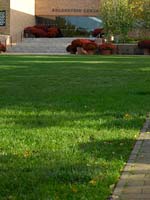
Green lawns can also be "green" (as in ecofriendly) lawns. In fact, some of the best tips for lawn care actually reduce our carbon footprint. For example, watering and mowing less often generally is more beneficial for grass.
Tom Tiddens, plant health care supervisor at the Chicago Botanic Garden, oversees the care and maintenance of more than 80 acres of grass, and he offers an array of tips to care for your lawn. These are turf tips that will turn your neighbors green with envy, and help the environment as they green the grass.
First Things First
A beautiful lawn starts with the right environment. Enough sunlight is key, as well as at least 8 inches of good, fertile soil. If you don't know your soil's composition, you may wish to run a soil test. Here are some tips to address soil problems and create a healthy growing environment.
Watering, Seeding, and Feeding
What's your approach to watering your lawn? Many gardeners choose to leave the watering to Mother Nature—if rain is scarce, lawns are just a bit browner. When drought conditions leave lawns thirsty, it is fine to let grass go dormant and save yourself gallons of water. When the rain does fall, green grass will return. If you choose to water your lawn, do so infrequently, but deeply. This strengthens grass by forcing roots to reach deep for water. The best time of day to water is just before dawn; moisture has a chance to seep into the roots, won't evaporate, but also won't foster mold or bacteria growth as it might, lingering from an evening watering. Consider collecting rainwater in barrels as your first watering resource.
When it comes to grass seed, you get what you pay for. Invest in high-quality seeds, but don't limit yourself to one type; lawns flourish with a mixture of grass types. Here at the Garden, we have found success with a mix of 80 percent bluegrass and 20 percent perennial rye, and within that is a blend of five different bluegrasses and three perennial ryes. Once that grass has grown and established itself, consider using core aeration to helps create a favorable environment for grass to thrive. Aerating loosens the soil, increases drainage, limits thatch development, and encourages good rooting. Aerate in late spring or early fall, and follow up with over-seeding.
Organic/natural fertilizers are a good substitute for synthetic fertilizers—they are just as effective if not more so. But remember: Less is more. Don't over-fertilize, and avoid fertilizers with high levels of phosphorus, which can lead to water contamination and algae blooms.
Did You Know?
American homeowners use more pesticides per square foot on their lawns than most farmers use in their fields! Try using natural bug busters, instead of chemicals. The same goes for herbicides; there are many naturally derived compounds available. You can even make them at home. A mixture of vinegar and salt or gin/apple cider/vinegar sprayed directly on weeds may do the trick without the need for expensive and toxic herbicides. The best way to manage weeds is to have a healthy, vigorous lawn that will out-compete them. And though it may seem like a fine line between what is a tolerable amount and what is unbearable, remember that a few weeds won't hurt your lawn.
Lawn "Mow-How"
Consider purchasing a mulching mower. It leaves behind finely shredded grass clippings, far smaller than traditional mowers. It is best for your lawn and the environment to leave clippings instead of bagging them for the landfill. Clippings return nitrogen to the soil, bolstering the health of your lawn. If you mow weekly, on dry days, clumping will not be a problem.
The most ecofriendly mowing method is push mower (enjoy the bonus of a nice cardio workout), followed by electric. The least ecofriendly mower is gas-powered.
Leave it long. For the health of your lawn, the ideal height is about 3½ inches. A taller lawn boasts deeper roots, holds moisture better, and increases photosynthesis. It also will deter weeds and foster healthier grass than a shorter lawn.
Keep your blade sharp. A dull mower blade will still cut, but the frayed ends will brown, leaving your lawn less vibrant.
Vary your routine. Each week mow in a different pattern. This will deter rutting and soil compaction.
Here are more lawn-care tips.

